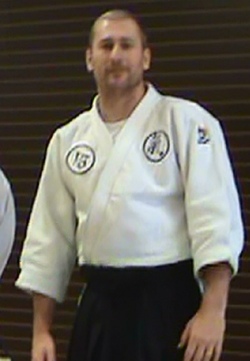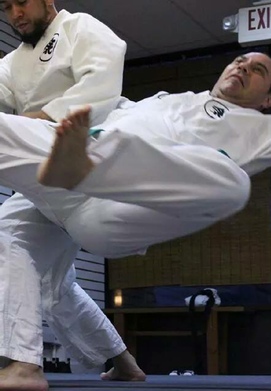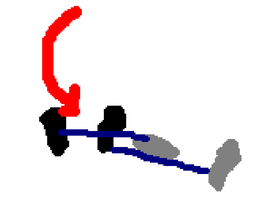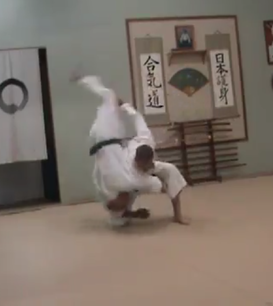


How To Create Variety During
Your Sho-Dan Test
By Jonathan Wilson
How to Break Out of Ruts During the Test
Watch any open randori session, and you can generally identify nage patterns in quick order. While there is no limit on the number of Arm Bars you might employ during the test, it is refreshing to see an occasional Arm Bar Throw, or a Spinning Arm Bar, or perhaps ~ dare I say it ~ “a Scissors Application!”
‘Variety’ it is the spice of life in all things; including aikido. In my training, I’ve worked with several students of all belt levels ~ myself being one of them ~ who at one point or another became frustrated at the lack of perceived variety in their free style defenses. Simply put, they wanted to do more than Arm Bars and Elbow Chops during their self defense test.
So let’s get a few things out of way before we delve into the notion of variety of technique. On the test you have 2 objectives.
#1. Your first objective is to not get hit.
#2. Your second objective is to employ appropriate aikido technique in a manner taught by your Sensei ~ that passes the sho-dan “visual” marker.
At best, the variety of techniques used on the test is a tertiary objective.
Still, as long as you are not getting hit, consistently unbalancing uke, and employing some descent, albeit repetitive, aikido technique ~ why not seek out some variety to spice things up?
Here are four suggestions for your consideration. The first two suggestions were given to me when I was a purple belt by Sensei John Carter. Sensei Lamar Sanders (Aikikai) helped me with the third suggestion, and I came up with the fourth suggestion on my own (although I’m sure many people have thought of this same idea before I came up with it).
#1 Change your initial movement. Particular movement patterns set up particular techniques. If you are in a rut off of straight punches, begin to enter or blend differently.
#2 Switch your blocks up. Particular blocking patterns set up particular techniques. If you are in a rut off of round punches using a 1 handed block, begin using push blocks instead.
#3 Rather than waiting around to “read” the attack and then reacting to it, decide where you want to end up relative to uke after his attack (regardless of how he attacks), and then get there. A video needs to be done to clarify this concept, because it really works well; especially when you’re dealing with multiple attackers (eg: attacks similar to the test card that reads, “Attacker A & B: Bring man down by any means necessary”). Perhaps I’ll get a video out for next month’s newsletter.
#4. Take some free time to organize your applications by strikes. So instead of listing all the applications you know for each technique (eg: “the Handshake”) list all the applications of technique that will work on a cross grab, a straight punch, etc. In this way, you develop a diverse list of techniques that you can run through for any given attack.
Here is a sample list of techniques that can be used in Defense Against a Roundhouse Punch:
From the White Belt Set
Elbow Chop
Leg Sweep
Mugger’s Throw
Unbendable Arm (enter straight down the line)
From the Yellow Belt Set
Peel Off
High Bridge
Low Bridge
Pivot Take Down
From the Blue Belt Set
Reverse Palms Lift UP
Two Hand Wheel Throw
From the Green Belt Set
Pivot Over the Back Throw
Back Breaker
Slap to the Side of the Head
From the Purple Belt Set
Cross the Body Wrist Throw
Spinning Hip Throw
Shoulder Throw
Groin Block
Body Block (*assuming sufficient attacker commitment)
When you get done with your lists, you’ll have separate lists for straight punches, upper cuts, jacket grabs, bear hugs, full nelsons, combination punches, grips from the side, front, back, chokes, etc.
Once you’ve got your lists together, you’ll want to practice them in order to internalize them. You might have your uke attack you with the same attack over and over again (eg: “Give me 20 straight roundhouse punches” ~ while I run through my mental check list.” Then tell your uke to switch to straight punches, combination punches, grips, etc.
This is ideal for open mat training opportunities. Finally, once you’re on the test, just mentally run down the lists as the attacks come.
* Keep in mind that in addition to the simple list that I provided for the round punches, there are all kinds of potential variations within that list (eg: adjusting the directions in which techniques are applied) which can be applied to further enhance your “wow” factor.
One Final Point: Don’t over think it. My experience has been that the more I think about doing a certain technique (or not doing a certain technique) the less fluidly I perform whatever it is I end up doing. For me, it generally works best to move first, take uke’s balance, and then perform whatever technique I have available to an unbalanced uke. I know I’m doing it wrong when I have to apply too much pressure to a technique to get it to work. This is patently obvious on “timing” techniques like “Slap to the Side of the Head.” When things are clicking on Slap to the Side of the Head, I am able to lead uke to the mat without measurable effort ~ and barely even making physical contact with uke’s head.
What say ye?

2014 - 2021 ngaexperience.com
Uke Appears Unhappy ~~~

Change In Your Movement =
Change In Your Technique


The Tenshin Movement ~ modified to operate out of a shizentai stance. It is a movement back and off line, offering tremendous kuzushi (balance breaking) opportunities. The Tenshin movement works especially well against round attacks. Unlike Irimi and Tenkan Movements, the Tenshin Movement draws uke into the space nage was holding.
The Tenshin Movement


I used the Tenshin Movement to get here ~ (see video below) also.
Uke’s attack was a backhand strike, which I parried well, stepping back with Tenshin movement to effectively unbalance Uke.... Then I undercut him with an evolved application. It’s a cross between a Body Block, Pivot Over the Back, Back Breaker, with a little Muggers Throw thrown in for fun.
While the fall is surprisingly easy, it’s still not a technique you want to bust out on someone with out confidence in their ukemi abilities.
Before my attack line test, I did this technique on every attacker to make sure they were ready for it.
Uke Appears Unhappy ~~~

@1:00 you can see the entire attack complete with Tenshin Initial movement

The Tenshin Movement

The Tenshin Movement ~ draws uke into the space nage was holding ~ unbalancing him. Uke’s back heel rising is a sign it’s being done well.